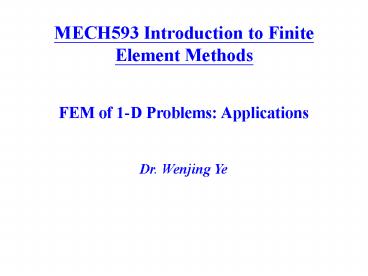MECH593 Finite Element Methods - PowerPoint PPT Presentation
1 / 46
Title:
MECH593 Finite Element Methods
Description:
MECH593 Introduction to Finite Element Methods FEM of 1-D Problems: Applications Dr. Wenjing Ye Heat Transfer Mechanisms Conduction heat transfer by molecular ... – PowerPoint PPT presentation
Number of Views:128
Avg rating:3.0/5.0
Title: MECH593 Finite Element Methods
1
MECH593 Introduction to Finite Element Methods
FEM of 1-D Problems Applications Dr. Wenjing Ye
2
Bending Beam
y
Review
M
M
x
Pure bending problems
Normal strain
Normal stress
Normal stress with bending moment
Moment-curvature relationship
Flexure formula
3
Bending Beam
y
Review
q(x)
x
Relationship between shear force, bending moment
and transverse load
Deflection
Sign convention
-
M
M
M
-
V
V
V
4
Governing Equation and Boundary Condition
- Governing Equation
0ltxltL
- Boundary Conditions -----
Essential BCs if v or is specified at the
boundary. Natural BCs if or
is specified at the boundary.
5
Weak Formulation for Beam Element
- Governing Equation
- Weighted-Integral Formulation for one element
- Weak Form from Integration-by-Parts ----- (1st
time)
6
Weak Formulation
- Weak Form from Integration-by-Parts ----- (2nd
time)
7
Weak Formulation
- Weak Form
q(x)
Q1
y(v)
Q3
Q2
Q4
x
x x2
x x1
L x2-x1
8
Ritz Method for Approximation
q(x)
Q1
y(v)
Q3
Q2
Q4
x
x x2
x x1
L x2-x1
where
Let w(x) fi (x), i 1, 2, 3, 4
9
Ritz Method for Approximation
10
Ritz Method for Approximation
11
Selection of Shape Function
The best situation is -----
Interpolation Properties
12
Derivation of Shape Function for Beam Element
Local Coordinates
How to select fi???
and
where
Let
Find coefficients to satisfy the interpolation
properties.
13
Derivation of Shape Function for Beam Element
How to select fi???
e.g.
Let
Similarly
14
Derivation of Shape Function for Beam Element
In the global coordinates
In the local coordinates
15
Shape Function and Interpolation
C0 Interpolation f is continuous at the
interface between elements. f,x is not
continuous at the interface between elements.
C1 Interpolation f and f,x are
continuous at the interface between elements.
f,xx is not continuous at the interface
between elements.
16
Element Equations of 4th Order 1-D Model
q(x)
u1
y(v)
u3
u2
u4
x
x x1
L x2-x1
x x2
f4
f1
1
1
f3
f2
xx2
xx1
17
Element Equations of 4th Order 1-D Model
q(x)
u1
y(v)
u3
u2
u4
x
x x2
x x1
L x2-x1
18
Finite Element Analysis of 1-D Problems -
Applications
Example 1.
Governing equation
Weak form for one element
where
19
Finite Element Analysis of 1-D Problems
Example 1.
Approximation function
f4
f1
f3
xx1
f2
xx2
20
Finite Element Analysis of 1-D Problems
Example 1.
Finite element model
Discretization
P2 , v2
P3 , v3
P4 , v4
P1 , v1
II
III
I
M1 , q1
M3 , q3
M4 , q4
M2 , q2
21
Matrix Assembly of Multiple Beam Elements
Element I
22
Matrix Assembly of Multiple Beam Elements
23
Solution Procedures
Apply known boundary conditions
24
Solution Procedures
25
Shear Resultant Bending Moment Diagram
26
Plane Flame
Frame combination of bar and beam
Q1 , v1
E, A, I, L
Q3 , v2
P1 , u1
P2 , u2
Q4 , q2
Q2 , q1
27
Finite Element Model of an Arbitrarily Oriented
Frame
y
q
x
y
q
x
28
Finite Element Model of an Arbitrarily Oriented
Frame
local
global
29
Plane Frame Analysis - Example
Beam II
Rigid Joint
F
F
Beam I
30
Plane Frame Analysis
Q3 , v2
Q4 , q2
P2 , u2
P1 , u1
Q2 , q1
Q1 , v1
31
Plane Frame Analysis
Q3 , v3
Q1 , v2
P1 , u2
P2 , u3
Q4 , q3
Q2 , q2
32
Plane Frame Analysis
33
Plane Frame Analysis
34
Heat Transfer Mechanisms
- Conduction heat transfer by molecular
agitation within a material without any motion of
the material as a whole. - Convection heat transfer by motion of a fluid.
- Radiation the exchange of thermal radiation
between two or more bodies. Thermal radiation is
the energy emitted from hot surfaces as
electromagnetic waves.
35
Heat Conduction in 1-D
Heat flux q heat transferred per unit area per
unit time (W/m2)
Governing equation
Q heat generated per unit volume per unit time
C mass heat capacity
k thermal conductivity
Steady state equation
36
Thermal Convection
Newtons Law of Cooling
37
Thermal Conduction in 1-D
Boundary conditions
Dirichlet BC
Natural BC
Mixed BC
38
Weak Formulation of 1-D Heat Conduction(Steady
State Analysis)
- Governing Equation of 1-D Heat Conduction -----
0ltxltL
- Weighted Integral Formulation -----
- Weak Form from Integration-by-Parts -----
39
Formulation for 1-D Linear Element
Let
40
Formulation for 1-D Linear Element
Let w(x) fi (x), i 1, 2
41
Element Equations of 1-D Linear Element
42
1-D Heat Conduction - Example
A composite wall consists of three materials, as
shown in the figure below. The inside wall
temperature is 200oC and the outside air
temperature is 50oC with a convection coefficient
of h 10 W(m2.K). Find the temperature along the
composite wall.
t3
t2
t1
x
43
Thermal Conduction and Convection- Fin
Objective to enhance heat transfer
Governing equation for 1-D heat transfer in thin
fin
w
t
x
dx
where
44
Fin - Weak Formulation(Steady State Analysis)
- Governing Equation of 1-D Heat Conduction -----
0ltxltL
- Weighted Integral Formulation -----
- Weak Form from Integration-by-Parts -----
45
Formulation for 1-D Linear Element
Let w(x) fi (x), i 1, 2
46
Element Equations of 1-D Linear Element































